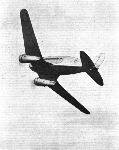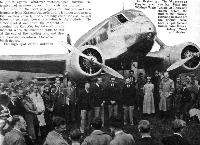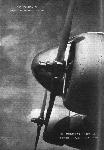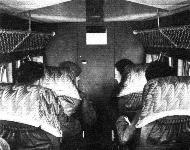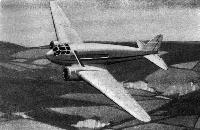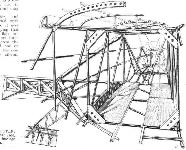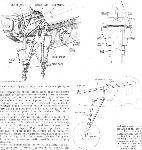General Aircraft ST-18 Croydon
Сохранив крыло типа Monospar от довольно удачных ранних самолетов семейства ST, компания "General Aircraft" приступила к проектированию авиалайнера вместимостью десять пассажиров, но крыло все-таки доработали так, что за счет подкосов нагрузку частично воспринимал еще и фюзеляж. Хвостовое оперение - традиционное, основные опоры шасси убирались и выпускались гидравликой, хвостовая опора не убираемая. Силовая установка состояла из двух звездообразных двигателей Pratt & Whitney Wasp Junior, смонтированных в аэродинамически очень чистых мотогондолах в передней части крыла. Кабина командира и второго пилота размещена в носовой части фюзеляжа, за ней находится рабочее место радиста. Салон на 10 пассажиров стандартно оснащен системой вентиляции и обогрева, в хвостовой части салона - туалет и большой багажный отсек.
General Aircraft ST-18 позже получил наименование Croydon. Первый полет самолет выполнил 16 ноября 1935 года. Несмотря на удовлетворительные характеристики, заказчиков на машину не нашлось. Карьера машины оборвалась при попытке установления рекорда в перелете из Австралии в Великобританию. Самолет с экипажем из двух человек выполнил аварийную посадку на атолл в Индийском океане, откуда летчиков эвакуировали местные рыбаки, но лагуна рифа Серингапатам стала для General Aircraft ST-18 последним пристанищем.
ТАКТИКО-ТЕХНИЧЕСКИЕ ХАРАКТЕРИСТИКИ
General Aircraft ST-18 Croydon
Тип: авиалайнер вместимостью 10 пассажиров
Силовая установка: два звездообразных 9-цилиндровых ПД Pratt & Whitney SB-9 Wasp Junior мощностью по 450 л. с. (336 кВт)
Летные характеристики: максимальная скорость на высоте 1525 м - 327 км/ч; экономическая крейсерская скорость на высоте 3960 м - 299 км/ч; практический потолок 5945 м; дальность полета с максимальной заправкой 1448 км
Масса: пустого 3629 м; максимальная взлетная 5148 кг
Размеры: размах крыла 18,14 м; длина 13,18; высота 4,09 м; площадь крыла 42,18 м2
Показать полностьюShow all
Flight, May 1935
THE NEW MONOSPAR
Yet Another Type, the S.T.18, Added to General Aircraft's Range: To Cruise at 160 m.p.h. with Ten Passengers: American Engines Used
BEARING a strong family resemblance to previous Monospar monoplanes, the new S.T.18, designed and now being built by General Aircraft, Ltd., of Hanworth, will, when it takes the air in a little more than a month's time, incorporate all the latest aids to performance coupled with safety, such as retractable undercarriage, trailing-edge flaps and controllable-pitch airscrews.
Externally the new machine will be chiefly remarkable for the considerable sweep-back of its monoplane wing. While this was doubtless desirable in order to get the centre of gravity and centre of pressure in the correct relative position, the arrangement probably has other advantages, such as the absence of a sudden and violent stall. In addition to their sweep-back, the wings are given a considerable "wash-out," i.e., the angle of incidence diminishes towards the wing tips. In a straight-wing aircraft the main advantage of this is that the centre of the wing stalls before the tips, and the machine is not so likely to go into a spin. When the wings are also swept back, the effect is likely to be that when stalling angle is approached, the nose drops gently and the machine begins to gather speed before any sudden or steep dive has developed.
From an aerodynamic point of view the S.T.18 follows in a general way the modern practice of cantilever wings and tail, retractable undercarriage, and generally clean design without avoidable excrescences. Particular attention has been given to the nose of the fuselage, not only with low drag in mind but also a good view for the pilots. The fact that the wing is placed low enables the pilots to look not only ahead and to the sides but also to the back. When the machine is standing on the ground, the crew can make sure that no other aircraft is about to land just as they are taking off.
In the main, the structural principles followed in the construction of the S.T.18 are similar to those which have characterised previous Monospar machines. This applies more particularly to the wing structure, which incorporates the now well-known Stieger-Monospar system, in which but a single main wing spar is used, located approximately one-third of the chord from the leading edge. This main spar, which is designed to be strong enough to carry the bending loads imposed by the weight of the machine, would be too flexible to resist the torsion which arises owing to movements of the centre of pressure. It is therefore reinforced by two sets of tie-rod bracing, each forming a spiral around the spar and its drag struts and running in opposite direction to the other spiral. A considerable saving in wing weight is claimed for this method of construction, but possibly even more important is the fact that when a wing tip deflects, it does so without altering its angle of incidence, and wing flutter is less likely to arise.
For the fuselage structure a change in the form of construction is to be recorded. It will be recollected that in previous Monospar machines a system of construction similar to that of the wing was adopted. A single member with spiral anti-torsion bracing formed the primary structure, and the final fuselage shape was provided by light formers and stringers, placed over the central backbone or keel member. The fuselage was, in fact, a form of chassis-and-body job. In the S.T.18 this type of fuselage construction has been abandoned for a more orthodox type, with four main longerons and diagonal strut bracing. The covering of both wing and fuselage is mainly with doped fabric.
The fuselage is composed of four distinct units: the front end, which contains the pilots' cockpit, the cabin, which is one unit, the rear fuselage portion, and a wedge-shaped structure carrying the tail wheel assembly. The cabin structure has been so arranged that it is entirely free of bulkhead bracing, and the average head room is 5ft. 9m. Seating accommodation for ten passengers will be provided, and the furnishing and interior decorations are to be carried out by Rumbolds. Heating of the cabin will be from a muff around an exhaust pipe, and while the main ventilation will be under the control of the pilot, passengers will have their individual ventilator controls. The total capacity of the passengers' cabin is 406 cu. ft. One long window will be built into each cabin wall, the only obstruction to the view being a few structural members which take up but a small part of the window space.
A very substantial bulkhead separates the pilots' cockpit from the cabin. This bulkhead is a main structure member, and to it are secured the wing roots and the two wing-bracing struts, so that all the major loads are concentrated here.
In the cockpit a very complete set of instruments will be installed, and the controls have been so arranged (the flying controls are, of course, in duplicate) that they can be reached by either pilot. This applies to engine controls and the controls for operating the wing flaps, the retractable undercarriage and the pitch of the airscrews, which, incidentally, will be Hamilton Standards.
The engines which have been selected for the S.T.18 are Pratt and Whitney "Wasp Juniors." It is understood that no suitable British engine of exactly the power and characteristics required was available. Fuel is carried in the wings, the maximum capacity being 200 gallons. At a slight extra cost a gravity tank can be provided, and this, of course, can, if desired, be used for a high-octane fuel to be used during the take-off, switching over to plain petrol when the operational height has been reached.
The retractable undercarriage is similar to those fitted on some of the smaller Monospar machines. Palmer hydraulic brakes with differential rudder bar control and parking ratchet will be fitted. The operation of the undercarriage and the wing flaps will be by electro-hydraulic means, a hand pump being provided for use in case of an electrical breakdown.
Показать полностьюShow all
Flight, May 1936
THE NEW MONOSPAR
General Aircraft's S.T.18. Cruising at Nearly 200 m.p.h.: Comfortable Accommodation for Ten Passengers: Reasons for Unusual Design
ONE'S reaction when seeing the new S.T.18 for the first time is to wonder at the somewhat unusual appearance of the machine. The very pronounced sweep-back of the wings, the short nose of the fuselage, which is almost in line with the two airscrews, the very low position of the tailplane over the ground, the straight bottom and somewhat hunchbacked shape of the fuselage are all features not commonly met with in twin-engined aircraft, and have obviously been introduced not merely for the sake of "being different," but for some very good reasons. Flight had an opportunity the other day of discussing these reasons with the designer of the machine, Mr. D. L. Hollis Williams, and it may be of interest if some of them are set out here before describing the details of the construction and internal arrangement of the machine.
It is a well-known fact that several modern high-speed twin-engined aeroplanes have a tendency to yaw slightly from side to side, a fact which points to a certain amount of directional instability. Another peculiarity of the twin engine arrangement is that, with one engine out of action, the rudder control necessary to hold the machine on its course is considerable, particularly if the engines are fairly widely spaced. Considerations such as these led to the adoption of the positioning of the fuselage rather unusually far back on the wing. Various effects result from this placing of the fuselage: the fuselage side area in front of the centre of gravity is reduced, that behind the centre of gravity is increased, and the lever arm, for a given fuselage length, on which the tail works, is increased. This rearward shift of the fuselage results, of course, in moving the centre of gravity back, and to restore the trim the sweep-back of the wings has been introduced.
The low tail position represents an attempt to make sure of getting the tail out of the area of disturbed airflow behind the wing at large angles of incidence; tins disturbance, with certain relative tail positions, sometimes sets up the phenomenon known as tail buffeting. This unusual shape of the fuselage results from the other considerations on which the design is based.
Apart from any saving in structure weight which may result from the use of the Monospar type of wing construction, a very practical advantage arises in its particular application in the S.T.18. Owing to the fact that there is but a single spar, braced to the top longerons on each side, there is only need for a single bulkhead in the cabin to be a primary structure member. The location of the spar so far forward in the wing section, and the short nose of the fuselage to which reference has already been made, bring the position of this single bulkhead well forward so that it can be used to form a partition between the pilots' cockpit and the cabin. The passengers quarters, as a result, are therefore quite unobstructed transverse structure members.
The primary structure of the fuselage is of normal type, with four tubular longerons and tubular struts. The struts are arranged in the form of a Warren girder, their ends being joined by plates and rivets. No wire or tie-rod bracing is used. Fairings are added to the primary structure to give the desired external form. The covering is doped fabric.
Single-spar construction is, of course, employed in the wing structure. The spar roots are attached to the lower longerons of the fuselage and serve, as in all monospar wings, to carry pure bending loads only. Torsion is of the normal monospar type, with tie-rod bracing outboard of the engines. In the wing roots a diagonal spar is added; this serves not only as a torsion member, but also to brace the wing against drag and engine thrust.
Ailerons, elevator, and rudder are provided with trimming tabs, and it goes almost without saying that split trailing edge flaps are fitted. The flaps are three in number, one across the centre section and one on each side, between the central flap and the aileron. Flexible material covers the gaps. The flaps are operated by push rods and links from a Dowty hydraulic unit.
In the retractable undercarriage, use is made of Dowty telescopic legs. Each of the Dunlop wheels is carried by two legs, and the retracting mechanism is of Dowty hydraulic type, with a movable horizontal cylinder and a stationary piston. The cylinder carries the crosshead of the retracting mechanism, and is so arranged that with the wheel fully down the position is over dead centre, so that automatic locking is provided. In addition, there is a hydraulic lock which comes into operation when the undercarriage is retracted. The hydraulic pump is operated by an electric motor, and can also be operated by hand.
The Pratt and Whitney Wasp Junior engines are carried on welded steel tubes and are carefully faired into the wing. The cowling on the under side is divided and hinged, so that it opens when the wheels are lowered, and closes when the wheels are raised. The principle and details are shown in some of the sketches.
Cabin accommodation is provided for ten passengers. The upholstery and sound-proofing have been carried out by Rumbold, and although the engines, with their variable-pitch airscrews, are very noisy, the amount of noise which reaches the passengers is very greatly reduced. The seats are arranged in the orthodox way down each side of the cabin, with a central gangway between the rows. Behind the cabin is a luggage compartment with a capacity of 41 cu. ft.
The temperature of the intake air is under the control of the pilot, so that not only can freezing of the carburetter be avoided, but, by feeding air of the right temperature to the engines, a maximum of power for all conditions can be obtained. As the machine is designed very much for all-weather flying, Goodrich de-icer equipment is fitted. Sperry blind-flying equipment is installed, the gyros being driven by vacuum pump from the engines. The air is taken from the cockpit to avoid freezing.
Very complete instrument and other equipment is carried. Reference has already been made to the blind-flying equipment. Smith's Aircraft Instruments have supplied the A.S.I., altimeter, turn and bank indicator, fore and aft level, compass (P.4), time-of-trip clock, cabin clock, rate of climb indicator, electric r.p.m. indicators (Record), oil gauges and thermometers, boost gauge, drift indicator, air log, cabin thermometer, electric fuel gauge, and landing headlamp with switch and dipping mechanism.
Demec navigation lights are fitted, and Rotax engine-driven generator. Interior lighting is by Bonella and Stedall and Co., the accumulator used being a Dagenite. The machine is equipped with R.T.E. radio. The price of the S.T.18 is L14,000. The first machine is named Croydon.
Показать полностьюShow all









